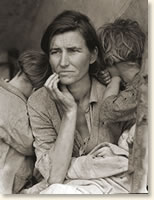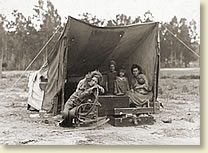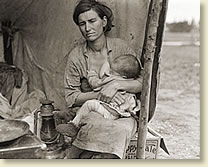|
Migrant Mother, 1936
The image of a worn, weather-beaten woman, a look of desperation on her face, two children leaning on her shoulders, an infant in her lap; has become a photographic icon of the Great Depression in America.
The photo was taken in March 1936 at a camp for seasonal agricultural workers 175 miles north of Los
Angeles by Dorothea Lange. Lange was working for the Farm Security Administration
as part of a team of photographers documenting the impact of federal programs
in improving rural conditions.
 |
| Migrant Mother, 1936 |
Lange had just completed a month-long photographic assignment and was driving back home in a wind-driven rain when she came upon a sign for the camp. Something beckoned her to postpone her journey home and enter the camp. She was immediately drawn to the woman and took a series of six shots - the only photos she took that day. The woman was the mother of seven children and on the brink of starvation.
After returning home, Lange alerted the editor of a San Francisco newspaper to the plight of the workers at the camp, presenting him with two of her photos. The editor informed federal authorities and published an article that included Lange's images. As a result, the government rushed a shipment of 20,000 lbs. of food to the camp. The photos' wider impact included influencing John Steinbeck in the writing of his novel The Grapes of Wrath.
In 1960, Lange described her experience in an interview with the magazine Popular Photography. The photos that accompany the following account are captioned with Lange's field notes:
"It was raining, the camera bags were packed, and I had on the seat beside me in the car the results of my long trip, the box
 |
"Nipomo, Calif. March 1936.
Migrant agricultural worker's family.
Seven hungry children and their
mother,aged 32. The father
is a native Californian." |
containing all those rolls and packs of exposed film ready to mail back to Washington. It was a time of relief. Sixty-five miles an hour for seven hours would get me home to my family that night, and my eyes were glued to the wet and gleaming highway that stretched out ahead. I felt freed, for I could lift my mind off my job and think of home.
I was on my way and barely saw a crude sign with pointing arrow which flashed by at the side of the road, saying PEA-PICKERS CAMP. But out of the corner of my eye I did see it I didn't want to stop, and didn't. I didn't want to remember that I had seen it, so I drove on and ignored the summons. Then, accompanied by the rhythmic hum of the windshield wipers, arose an inner argument:
Dorothea, how about that camp back there? What is the situation back there?
Are you going back?
Nobody could ask this of you, now could they?
To turn back certainly is not necessary. Haven't you plenty if negatives already on this subject? Isn't this just one more if the same? Besides, if you take a camera out in this rain, you're just asking for trouble. Now be reasonable, etc. etc., etc.
Having well convinced myself for 20 miles that I could continue on, I did the opposite. Almost without realizing what I was doing I made a U-turn on the empty highway. I went back those 20 miles and turned off the highway at that sign, PEA-PICKERS CAMP.
 |
"Destitute in a pea pickers camp,
because of the failure of the early
pea crop. These people had just sold
their tent in order to buy food." |
I was following instinct, not reason; I drove into that wet and soggy camp and parked my car like a homing pigeon.
I saw and approached the hungry and desperate mother, as if drawn by a magnet. I do not remember how I explained my presence or my camera to her but I do remember she asked me no questions. I made five exposures, working closer and closer from the same direction. I did not ask her name or her history. She told me her age, that she was 32. She said that they had been living on frozen vegetables from the surrounding fields, and birds that the children killed. She had just sold the tires from her car to buy food. There she sat in that lean-to tent with her children huddled around her, and seemed to know that my pictures might help her, and so she helped me. There was a sort of equality about it.
The pea crop at Nipomo had frozen and there was no work for anybody. But I did not approach the tents and shelters of other stranded pea-pickers. It was not necessary; I knew I had recorded the essence of my assignment."
References:
Lange, Dorothea, "The Assignment I'll Never Forget: Migrant Mother," Popular Photography (February 1960); Curtis, James. Mind's Eye, Mind's Truth: FSA Photography Reconsidered. (1989).
How To Cite This Article:
"Migrant Mother, 1936," EyeWitness to History, www.eyewitnesstohistory.com (2005).
|






